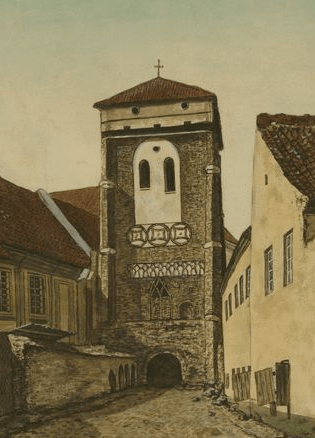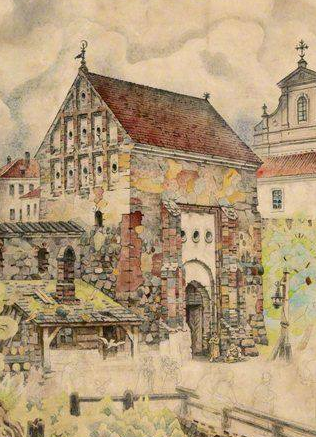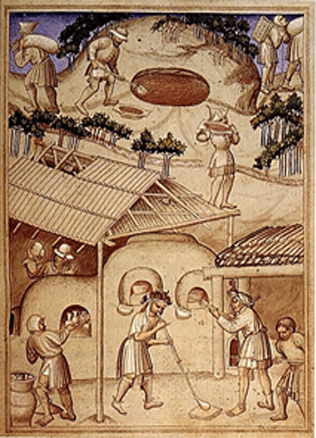Tabletop Games: Dice and Chess
In the Middle Ages and the Early Modern Period, people of any social class did not have to hurry. They had plenty of free time every day, in sharp contrast to our generation. Some people would find themselves absorbed by a routine of doing nothing, some of them would try to overcome it. Every person had her or his ways of fighting idleness, often by spending time with friends where games and razzles were common.
A “disgraceful” die
We do not know anything about how peasants would spend their free time. They had very few options because their lives were usually confined to the narrow circles of neighbours and their extended families. Peasant life did not seem attractive to writers and other literate people of the time. In contrast to that, there are abundant written and archaeological sources providing information related to the “killing of time” among city residents. One article in the hire agreement left by a mid-16th-century merchant from Kaunas represents a comprehensive list of activities that his employee must restrain from: “Abstain from drinking beer, either Lithuanian or German, wine and mead and vodka […], hold back from playing cards, dice, balls, draughts and all other infamous games for two years [i. e. until the agreement expires].”
The aforementioned games were considered infamous because people usually combined them with alcohol; in addition to that, games often involved money.
The wicked blend would end up in fighting and prolonged legal proceedings. A subject of the ruler from Polotsk wrote in his complaint in 1535 that another resident of the city had invited him to a dinner. They drank there for several days in a row and spent one night playing different games for money. When a Fortune finally smiled at him (пофортунило ми ся), the owner of the house got angry and beat him before throwing him to the street. It is unlikely the two were playing cards, as they were just beginning to spread in the country (we cannot dispose of the possibility though). Most probably, they played dice, the traditional game of the time.
We have no accurate information as to when a typical cube-shaped dice with pips on its faces, invented in the Antiquity, reached Lithuania.
Archaeologists claim they have unearthed a 13th-century dice made of bone in Kernavė, the finding that leaves little doubt that dicing was already spreading in Lithuania from that time on.
Archaeological excavations in Lithuania have not yielded a single dice from the 15th or 16th century but written sources indicate that dice were widespread at that time.
The 1579 questioning of Petras Petkevičius, a local canon and a parson of Betygala, is one of such documents found in the Diocese of Samogitia: “When asked if he had been in Vilnius at that time, he replied: […] “I was there for treatment.” When asked whom he had stayed with, he replied: […] “I also visited Martynas in the city square.” When asked what was the name of a person he played dice in Vilnius with, he replied: “I did not.” When the question was repeated, he said: “I played, but I do not remember his name.” […] When asked what he had diced away in Vilnius, he replied: “I diced away a gilded chain worth ten złotys.” When asked again, he said: “Your Grace, does it change anything if you know how many złotys I have diced away?“ When asked once again, he said: “I diced away threescore of mites.” And when asked once again, he said: “I will not behave that way anymore…”
How did the rulers have fun?
Leaders of the Church and many European states were well aware that craving for the outbursts of adrenaline lead to disastrous consequences, therefore they put efforts to curb irresponsible decisions. The legislation of the Grand Duchy of Lithuania did not ban dicing though. Instead of the law, moral exhortations and public contempt were employed as tools to control the habit. The tradition is reflected in the Statute of Wislica, the code by the king of Poland Casimir the Great translated into the Ruthenian language and still in force in the 14th and 15th century in south-western lands of the GDL, as well as in the Article 24 of Chapter 12 of the Third Statute of Lithuania. The latter links dicing unambiguously to service men, such as soldiers and servants “who take no other work that that of dicing and drinking” (ниякою работою не бавять ся, на костырстве и пьянстве часъ свои травять).
It seems that this kind of attitude to dicing was symptomatic because already in the 16th century the public opinion treated dice games as an entertainment of the ruck. It needs to be said though that dice were used not just in trivial games for money. More and more people played backgammon and lotto-type games in public using dice to count movements. In private environments, though, the tradition of fortune-telling using dice apparently has never been eradicated. In other words, dicing never really left the sphere of entertainment of the elite.
While dicing was a “vulgar” game, chess was the pastime of the elite.
According to Jan Długosz, Vytautas – the exemplary ruler of Lithuania – was a keen chess player. His cousin Jogaila showed some interest in the game too, although it is not clear whether his attraction was natural or influenced by Vytautas. Several other 15th– and 16th-century rulers of Lithuania played chess too, at least occasionally, including Władysław II Jagiełło‘s son Casimir, and Casimir’s son Sigismund the Old. Historical sources, however, provide no information on the matter as far as Sigismund the Old’s son, Sigismund Augustus, is concerned. Was it because of his fiery temper that the last representative of the Jagiellonian dynasty could not concentrate on the chessboard? Or perhaps his closest environment simply did not consider it necessary to document Sigismund August playing chess as that game had never brought him any emotion worth mentioning? After all, playing chess was part of the culture of the royal court in the 15th and 16th century. Even if we presumed that Sigismund Augustus was not interested in chess at all, his wife Barbara Radziwiłł did compensate that in a way, because she had a luxurious set of chess.
At all times, lower classes of the society were keen imitators of the culture of the rulers’ court, and this is how traditions of the elite would spread in province. The same model applies to the propagation of chess in Lithuania. There are no written sources indicating that the game was popular among the lower-rank provincial nobility in the 16th century. Despite that, scepticism of the historians has been largely dissolved by archaeological findings, which include more than 40 chess figurines from the 14th and 15th century. Many of them have been found in Vilnius and Trakai, the residence cities of the court of the Grand Duke of Lithuania. Some chess pieces have also been found in Kaunas, Kernavė, Veliuona and Dubingiai, the towns and cities with mediaeval castles later converted into state-run manors. Even though playing chess was not widely popular in the 15th– and 16th-century Lithuania, a chess set was not a rarity in the country.
Literature: P. Blaževičius, Seniausieji Lietuvos žaislai, Vilnius, 2011; Žemaičių vyskupijos vizitacija (1579) (Historiae Lithuaniae fontes ecclesiastici, t. 1), vertė L. Jovaiša, Vilnius, 1998, p. 128–129
Eugenijus Saviščevas



